Why STATIC?
Turning is a very dynamic process - the wood spinning, the tool moving in/out, left/right, up/down - and usually being rotated - on TWO axis at the same time. Wood ribbons stream off the piece or chips literally fly - all over hell. And when you get into it - your whole body is moving. But when you're done - the piece you made is - STATIC. It just sits there - stationary. Sure you may have created implications of movement - the swirl of the grain, some areas with chatoyancy (think Tiger Eye stone in a ring or necklace), maybe some carving with sweeping lines. Implied movement ain't ACTUAL movement.
Why not include ACTUAL movement? You've got SIX degrees of freedom of movement - why not try working one or more into a piece.
SIX degrees of freedom of movement? I thought there were only three
- left / right, in / out and up / down.
You overlooked ROTATION - around each of the THREE axis. See?
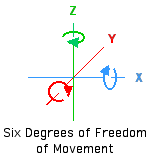
Now that you've have an idea of what you've got to play with, here are some ideas to play with:
Though you'd normally want the base of a turning to be flat - so the piece will sit stabile - why not leave a little high spot so the piece can rock - a little - but not enough to fall over?
Want more movement? Play with Hyper Ellipsoids / Super Eggs.
Hyper what!?
You think I should turn Giant Eggs?
Are you nuts?
When you're looking for "creative ideas", coming up with CRAZY ideas is sort of part of the process - though it sounds better if you call it Thinking Outside The Box.
As for Hyper Ellipsoids / Super Eggs, think more in terms of those old inflatable punching bag toys - you poke it, it wobbles back and forth and rights itself. Even if you knock it down - it rights itself - after wobbling back and forth for a while. If you work out the right shape, and leave the bottom real thick to keep the center of gravity real low - it'll wobble - but won't fall down - or over.
Building in controlled instability - emphasis on controlled instability - you don't want things actually falling over, or rolling of onto the floor - can add movement to a piece.
Here's another idea - A Ball and Cup Swivel Joint
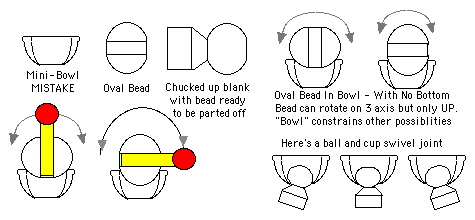
And here are some ideas to use a ball and socket / swivel joint to add movement to a piece.
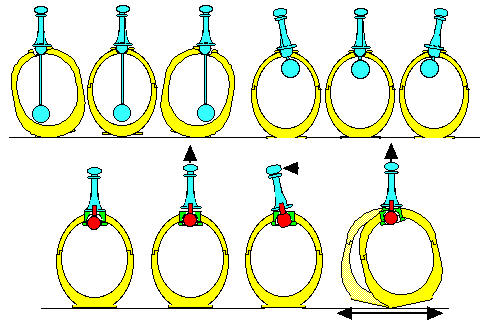
Ball & Socket / Swivel joints allow for movement. But what if you want to contrain the movement to just one or maybe two of the Six Degrees Of Freedom?
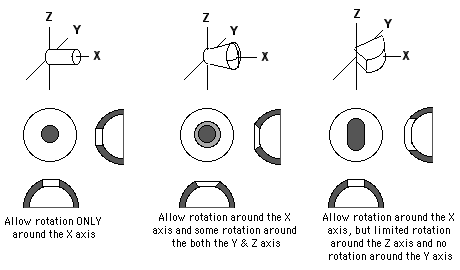
Want a different kind of movement option? How about using coil springs, the little ones? Too obvious - too orbtrusive? How about using small diameter - spring - wire? Stop by a musical instrument store and pick up some steel quitar strings, the "unwound" ones. Or visit a hobby shop - they've got small diameter spring wire too.
Springs? Spring wire? What the hell am I going to do with THEM?
Well - you could just use it to stick something on - and spin around. Or you could use a longer one and have the piece you stuck on the end rock / swing off it - or maybe both. Her's a piece to illustrate the idea. One end of the wire - yes, if you look closeley you'll see there is a wire - is glued into a hole in the twig / little branch unde the dragon fly. The other end fits in a hole on the underside of the dragon fly - but not glued. So the dragon fly can pivot AROUND on the end of the wire - moved by the slightest breeze. Touch it and the dragon fly will rock back and forth - maybe while it is turning left right.
Oh - and the wings. If they've got a smaller spring wire bent to follow the leading edge - and glued on - with the other end of the little wire glued in a hole in the side of the dragon fly's body - they'll move too - just a little - like fluttering wings - like dragon fly wings move.
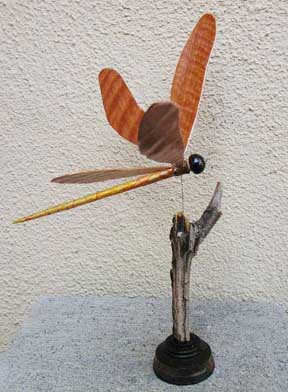
You can bend the wire some - and stick something on the end - over something under it - and get a variation of this. Touch or lift the piece and the little hammer starts "swinging" - and stays swinging for a little while.
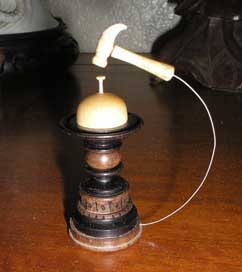
How about turning a bowl - with an overhanging towards the center rim? Put a marble - or a small turned sphere if you prefer - inside. Move the bowl - and the marble will roll - and make a sound. Pick it up and rock it in a circular motion - and the ball will roll around - the faster you rock it the higher up the side it'll roll - AND - the sound it makes as it rolls will change.
Want some more ideas for adding movement? CLICK HERE and a new window will open with more ideas. Close the last window you view to get back here.